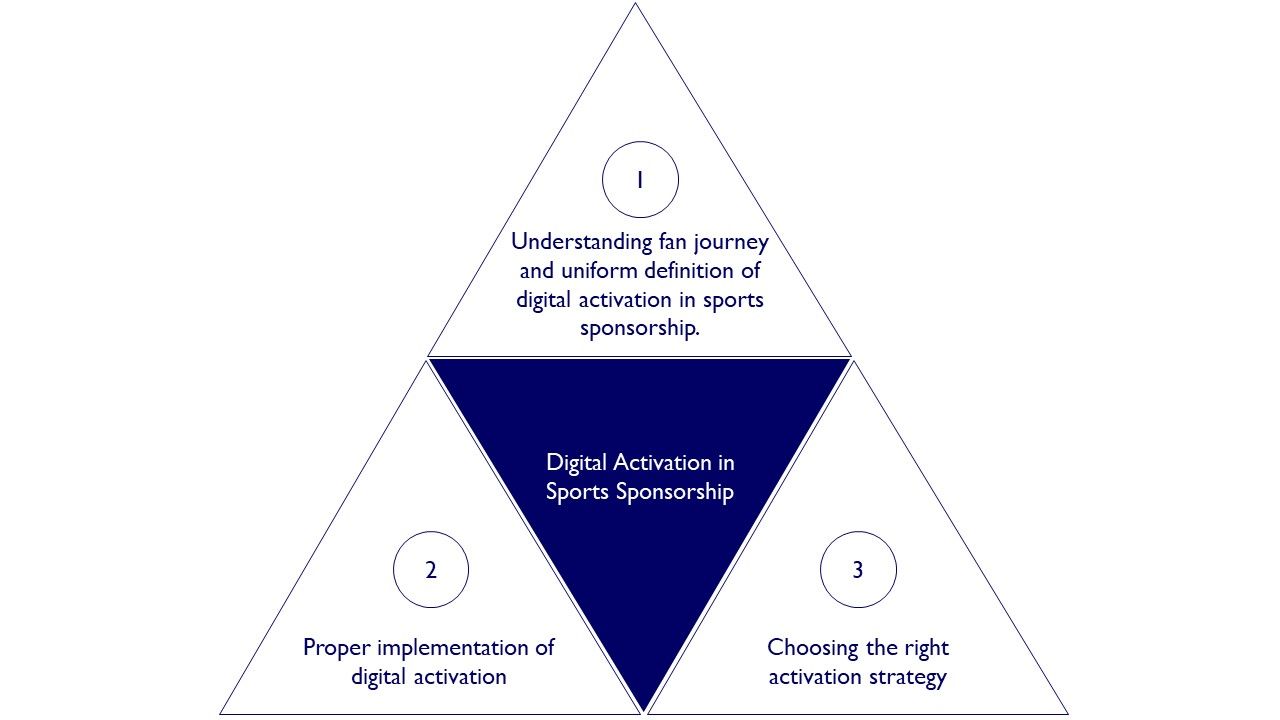Digital Activation in Sports Sponsorship: Is there Room for Digital in Sports?
Sports and sponsorship thrive on the emotions of the spectators on site. Those who play sports themselves or cheer along with their favourite club or athlete will remember special live events for a long time to come. This unique opportunity to convey emotions has not escaped the attention of companies, which are increasingly using sports sponsorship as a communications instrument and whose sponsorship spending has risen from $33.4 billion in 2011 to $46.1 billion in 2019 (excluding activation expenditures).[1] This has established sports sponsorship as one of the most effective marketing instruments.
Can we manage the digital transformation in sports sponsorship, and do we even want to?
Sports, for instance, used to think they were invulnerable until the Covid 19 pandemic hit the entire industry hard. So basically, one could say it’s not a question of wanting to, but rather a question of having to, and therefore implementing.
Social media, streaming services or other digital channels are playing an increasingly important role for sports fans while they themselves are practicing sports, viewing sports content, or interacting with other fans. The necessity to activate fans digitally as well has become a phenomenon in sports sponsorship and requires operational and strategic management. Consequently, it is crucial to understand how companies can utilize digital activation in their sports sponsorship activities and how digital activation needs to be managed. Based on a qualitative empirical survey of 13 managers* from the perspective of sponsors, rights holders and third parties (digital agencies, researchers), the following recommendations can be made:

Figure 1: Digital activation in sports sponsorship (Source: Ceka, 2022)
1. Understanding fan journey and uniform definition of digital activation in sports sponsorship
Companies pursue different objectives with sports sponsorship, whereby these are particularly achieved through the activation of sports sponsorship rights. The acquisition of rights alone is not enough. Nor is it helpful simply to place logos. Rather, companies must activate the rights they have acquired. However, understanding of sponsorship activation is still low, although companies describe it as an untapped potential.
The “digital fan journey” on a match day is very different from the “analogue fan journey”. While the analogue journey can be divided into “before, during, after”, the digital journey additionally includes the “community”, which is an indication of an extended journey. Companies can use different analogue and digital activation measures along the fan journey. The activation opportunities have become even broader and more diverse as a result of digitalization. Finally, the objectives of analogue and digital activation measures also differ from company to company [2]. In the case of digital activation, sales objectives are increasingly cited, partly because of better controlling.
From our research, we can see that sponsors, rights holders, agencies and fans have a different understanding of digital activation. Not all stakeholders are aware of when to refer to digital activation in sports sponsorship. For example, LED banners in stadiums are sometimes seen as digital activation, although this does not correspond to the actual understanding of digital activation. For a uniform understanding of digital activation, we follow this definition:
Activation encompasses all communication measures and actions in which fans become active and interactively involved, with the aim of promoting the sponsoring audience’s engagement, involvement, integration, or participation with the sponsor. Digital activation uses modern technologies, digital channels and platforms to activate fans.
2. Proper implementation of digital activation
Digital activation in sports sponsorship is proving to be extremely complex and challenging for companies, which explains the untapped potential in practice. The active involvement of recipients in a digital world only displays its full effect if it is executed correctly. The consequences of poor execution can be devastating for both the recipients and the sponsoring company in terms of fan engagement, fan experience, or emotionality.
To start with: There is simply no such thing as an all-in-one solution. But there are some success factors for activating digital sponsorships that can be summarized in 5 categories:
(1) Collaboration between sponsor and rights holder as well as other stakeholders.
(2) Knowing the objective and target group by means of data management
(3) Offering real added value
(4) Choosing the right technology
(5) No-line activation
(1) The basis for successful digital activation is good collaboration between rights holders and sponsors. But not only that: Collaboration with all other stakeholders such as agencies or media is also important. The network idea is often neglected today – digital activation should also be cross-sponsor and cross-club, and both rights holders and companies should act as media. Clubs and companies sometimes have more subscribers on their social media channels than large media houses. A good example of this is FC Bayern München, which works closely with all sponsors and their digital agencies in the form of a genuine network partnership [3].
(2) Digital activation requires data-driven conceptualization of activation campaigns, starting with the definition of objectives and target groups. Fans and their needs must be better understood based on data. Targeted communication increases interaction and conversion rates with fans. As part of best practice, SAP supports all partners with the necessary data infrastructure and also provides real-time data for fans [4].
(3) Based on good collaboration and understanding of fans, an activation campaign can be created. The key is to offer fans real added value. Sponsors must think in terms of solutions and give free rein to creativity. In a digital activation, fans must be actively involved because participation creates added value. The activation campaign must also be authentic and fit the brand’s actual offerings and services. In this context, we are talking about the fit of the digital activation campaign with the brands image and the sponsor’s offerings. While fans feel a great acceptance towards sponsors, the commercialization idea of an activation campaign must not be in the forefront. Especially with digital activations, this problem becomes apparent in practice when sponsors are almost exclusively focused on sales. Companies and sponsors such as Red Bull, Adidas, Nike or Coca-Cola are heavily involved in sports sponsorship and best practice examples of sales-driven digital activation, while focusing on creating real value for fans.
(4) Once it is clear which solution will be offered to the fans, the right technology must be found. Of course, social media channels are very important today, but sponsors should always check which channels are currently relevant. It should also match the activation campaign to the channel and integrate the channels. Simple copy-pasting from one social media channel to another should be avoided. Attention should be paid to more modern technologies such as virtual reality, augmented reality, holograms, blockchain or the metaverse. However, it is advisable to keep a close eye on these technologies. Often, sponsors think that deploying such technologies will cost a fortune. However, their use is already possible with smaller investments. An evaluation is therefore worthwhile in any case.
(5) The increasing importance of digital activation does not indicate that sponsors can now neglect offline activation. Analogue and digital are not opponents, but “play on the same team”. The supreme discipline lies in linking online and offline activation, even if this is one of the most difficult tasks for sponsors. The key is to keep visitors engaged even after they have attended a sporting event through digital activation (hashtags on social media, apps, etc.). A good example of this is the photo campaign of 1. FC Köln and Rewe, where fans can upload a selfie and, with a bit of luck, it will appear on the stadium display at the next home game [5].
3. Choosing the right activation strategy
In addition to individual activation activities and different objectives, companies also pursue clear activation strategies to achieve overarching marketing communication objectives. Although the importance of integrating these objectives is well known in research and practice, there are no typologies or taxonomies that integrate both the form of activation and the objectives of activation. The former deals with the discussion of analogue and digital forms of activation, the latter with objectives such as brand or sales orientation. We would like to investigate which (digital) activation strategies exist and which strategy is the right one in which situation and formulate recommendations for the entire sports industry.
The potential of sports sponsorship has significantly grown as a result of digital opportunities. If companies or sponsors can properly utilize new technologies, digital channels and platforms to develop new fan engagement or fan experience strategies that didn’t exist in the days of purely analogue activation, they will differentiate themselves in the markets and gain sustainable competitive advantages. To conclude the provocative question: Yes, digital has a place in sports and we want it too!
Stay tuned or be proactive and contact me directly for an expert interview. If you are interested in the study results, please fill out the form below.
[1] McDonald, J., & Clapp, R. (2020). Global Ad Trends: Sports Sponsorship Investment. WARC. Abgerufen unter https://www.warc.com/content/article/warc-data/global-ad-trends-sports-sponsorship-investment/en-GB/131033
[2] Ceka, M. (2022). Digital Activation in Sports Sponsorship [Research Proposal]. University of St.Gallen.
[3] Bayern München (2022). Abgerufen unter https://fcbayern.com/de/club/partner
[4] SAP (2022). Abgerufen unter https://www.sap.com/swiss/about/company/global-sponsorships.html
[5] Gundelach, J. (2020, Mai, 26). REWE bringt Fans auf virtuellen Banden. W&V. Abgerufen unter https://www.wuv.de/Exklusiv/Specials/Sportmarketing-Summit-2020/REWE-bringt-Fans-auf-virtuelle-Banden
